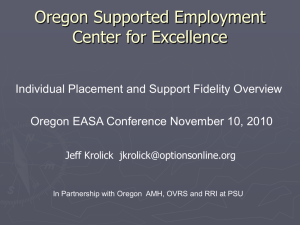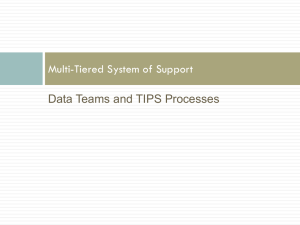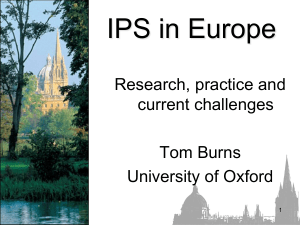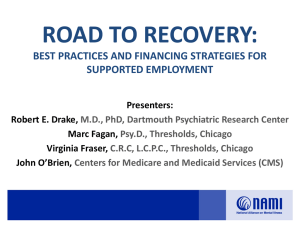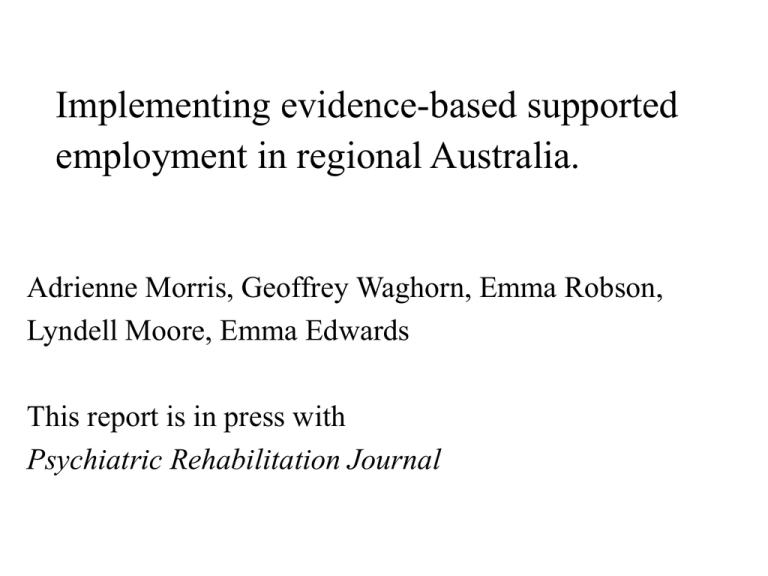
Implementing evidence-based supported
employment in regional Australia.
Adrienne Morris, Geoffrey Waghorn, Emma Robson,
Lyndell Moore, Emma Edwards
This report is in press with
Psychiatric Rehabilitation Journal
Objective:
To implement the Individual Placement and
Support (IPS) approach at four locations in
regional New South Wales, Australia. Outcomes
attained were compared to a national non-IPS
program, and to international trials of IPS within
and outside the USA.
Background: Current employment among people
with severe mental illness in Australia
• The second national survey of psychosis in Australia (n=1825,
Waghorn et al., 2012) shows that from 1997 to 2010, the
proportion of people with psychotic disorders that were
employed in the past 4 weeks, remained relatively stable at
around 22%.
• A second report (Waghorn et al., in press) found that clients
with psychotic disorders who used a DES service were more
likely to end up in non-competitive employment, compared to
those that used their own resources to find employment
• DEEWR evaluation report of 2012 shows only 24.5% of
people in DES ESS with a primary psychiatric disability
commenced employment after 6-9 months employment
assistance
The formal partnership approach
• Direct employment of employment specialists not practical
due to State-Federal Disability Services agreement (CSDA)
• Disability Employment Services in Australia are established
throughout Australia and receive recurrent case-based
funding.
• Many Community Mental Health Services typically do not
routinely refer clients to DES providers
• DES capability for working with clients of CMH services
unclear
• Many DES providers (generic and specialist) claim to use
IPS practices already, but at a national level outcomes
indicate otherwise
Target group (inclusion criteria)
• People with SPMI (psychotic disorders) of working age (18-64
years) who are current clients of the public funded MH services
and provide written informed consent
• The client has expressed a goal of wanting to work and is
willing to accept help to get and keep a job
• The client is not currently employed
Methods
• Four sites (Peel, Lake Macquarie, Newcastle, Hunter Valley,
established formal partnerships with the local mental health
service continuing care teams and co-located an employment
specialist into each team.
• Technical support of about 5 hours per week was provided to
each site by the HNE MHS, consisting of 2 full-time OTs and
one part time evaluation officer.
• At least one external fidelity reviews were conducted at each
site.
• A steering group and site coordinator was established at each
site, from existing resources, and initial training was provided
to all interested staff
• Ninety five mental health service clients commenced
employment assistance and were tracked for a minimum 12
months.
The intervention: the Becker-Drake IPS approach
Seven evidence-based principles (assessed by 15-item
fidelity scale)
–
–
–
–
–
–
–
1. Eligibility is based on consumer choice
2. Supported employment is integrated with clinical treatment
3. Competitive employment is the primary goal
4. Rapid job search (within 4 weeks)
5. Job finding, and all assistance, is individualised
6. Follow on supports are continuous
7. Financial planning is provided
• DES services are typically segregated from health services,
yet often claim to deliver other principles.
Figure 1. Competitive Employment Rates in 16 Randomized
Controlled Trials of Supported Employment
90%
80%
70%
60%
50%
40%
30%
20%
10%
0%
96
NH
(IPS)
07
Aust
(IPS)
94
NY
(SE)
07
IL
(IPS)
04
CT
(IPS)
05
HK
(IPS)
06
SC
(IPS)
Supported Employment
06
99
MA
DC
(ACT) (IPS)
Control
07
CA
(IPS)
95
IN
(SE)
Control 2
07
EUR
(IPS)
06
QUE
(IPS)
00
NY
(SE)
97
CA
(SE)
02
MD
(IPS)
Expected Benefits
• Based on a recent successful IPS implementations in
Australia (Killackey et al 2008; Waghorn et al, 2012) we
expected to achieve similar results as USA controlled
trials (Bond et al. 2012).
• We expected employment commencement results to
exceed DES (24%) after a comparable 9 months of
assistance
• Service integration was expected to benefit both the DES
provider and the CMH teams through sharing specialist
knowledge
– CMH team becomes more recovery oriented and client centred;
– DES partner develops greater capability to help more challenging
clients
Results 1
•
•
•
Two sites achieved good fidelity to IPS principles (100,103/125)and two sites
achieved fair fidelity (78,83/125). All sites had room for improvement on at least 17
of the 25 fidelity items.
Sites reported a similar participant mix by age, sex and diagnostic category (see
Table 1).
The overall referral commencement rate was 54.3%. The majority of noncommencements (46%) were due to the client declining assistance. For 11% the
reason was not recorded, and 10% were declined through already being employed.
Referral commencements varied from 46.7% at Lake Macquarie to 69.4% at Peel.
Results 2
• Attrition was defined as commencing assistance and exiting before
obtaining a vocational benefit. Over 12 months, attrition reached 21.1%
overall, ranging from 0% at Peel to 44.4% at Newcastle.
• Over 12 months the four sites achieved a mean proportion commencing
competitive employment of 57% (54 of 95). Over nine months 47.4% (45
of 95) commenced employment, which was significantly better than the
national benchmark of 24.5% over the same period (OR=2.77, CI=1.85–
4.15, p<.001).
Results 3
•
•
•
The proportion commencing employment over 12 months varied from 39% at
Newcastle to 72% at Peel. When formal education and training activity was added
to competitive employment, 67% obtained a vocational benefit over 12 months.
In terms of continuing employment for 13 weeks or more, 45% attained this
milestone in 12 months. The 9-month results favoured IPS by 35.8% (34 of 95) vs.
13.6% (1111 of 8165); (OR=3.54, CI=2.32-5.41, p<.001).
Over 12 months 32.6% of IPS participants attained 26 weeks employment, although
no national benchmark was available for comparison.
Results 4
•
•
•
•
•
Over 12 months 32.6% of IPS participants attained 26 weeks employment, although
no national benchmark was available for comparison.
The mean duration from referral to commencing job seeking was 55 days, ranging
from 30 days at Peel to 79 at Hunter Valley.
The mean period from referral to commencing the first job was 149 days, ranging
from 90 days at Peel to 217 at Hunter Valley.
Job diversity was good at all sites with the number of different job types (48)
approaching the total number of jobs (54).
Mean weeks worked and hours worked were similar to USA studies (approx.
20x20; Bond et al, 2012), however hourly wages were higher than most
international studies (site mean hourly wages ranged from $AU19.7-$AU25.6).
Discussion
• These results replicate the finding (Killackey, Jackson & McGorry, 2008)
that IPS can be implemented in Australia with good fidelity (Bond, Drake &
Becker, 2012).
• Different barriers to higher fidelity were found at each site, suggesting
that all could attain good to exemplary IPS fidelity.
• All four sites were implemented with external on-site support of five hours
per week, using the same partnership model, in the same service delivery
context, under the same contract conditions. Despite these similarities
several notable site differences remained.
• The four sites involved partnerships with four different local employment
services with different approaches to service delivery before IPS practices
were introduced.
• Sites also differed by referral acceptance rates, attrition rates, IPS fidelity,
time to commence job searching, and employment outcomes.
• Power and sample sizes were insufficient to compare locations, hence the
focus on aggregated results in this report.
Conclusions
• IPS was significantly better (2.8 times greater odds), than
national non-IPS services compared over the same follow-up
period, in terms of commencing competitive employment.
• IPS clients had significantly better odds (3.5 times greater) of
reaching a 13-weeks employment milestone.
• Yet, despite these encouraging results, implementing IPS at a
regional level remains challenging in Australia.
• Factors other than program fidelity appear to contribute to
excellent employment outcomes.
• Formal evaluations of new implementations are needed to
identify these factors.
• There is no reason why Qld implementations cannot exceed
these NSW results.
Related reports
•
1. Waghorn, G., Saha, S., Harvey, C., McGrath, J. et al. (2012) Earning and learning in people
with psychotic disorders. Results from Australia's second survey of psychotic disorders.
Australia and New Zealand Journal of Psychiatry, 46(8), 774-785.
•
2. Waghorn, G. Childs, S., Hampton, E., Gladman, B, Greaves, A, Bowman, D. (2012).
Enhancing community mental health services through formal partnerships with supported
employment services. American Journal of Psychiatric Rehabilitation, 15(2), 157-180
•
3. Morris A, Waghorn G, Robson R, Moore L, Edwards E. (in press) Implementation of
evidence-based supported employment in regional Australia. Psychiatric Rehabilitation Journal.
•
4. Waghorn G, Saha S, McGrath JJ. (2013). Correlates of competitive versus non-competitive
employment among people with psychotic disorders. Psychiatric Services. early online
•
5. Carr VJ, Waghorn G. (2013). To love and to work: Increased participation as the next major
mental health reform goal. Australian and New Zealand Journal of Psychiatry, 47(8), 696-698.
Contact welcome at ‘geoff_waghorn@qcmhr.uq.edu.au’


